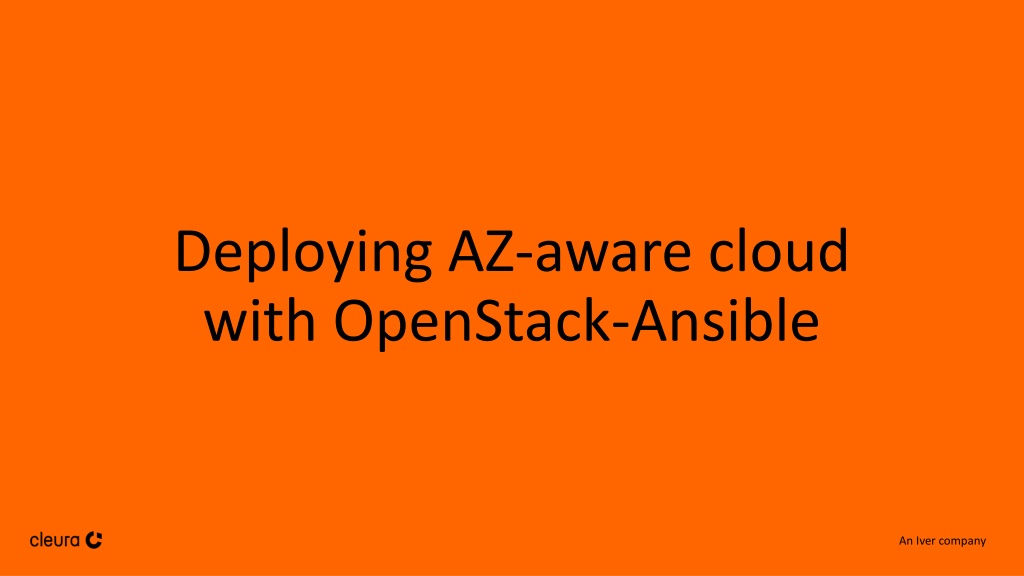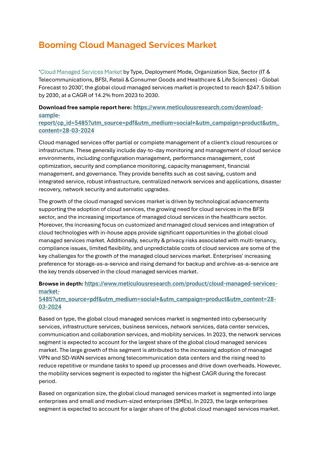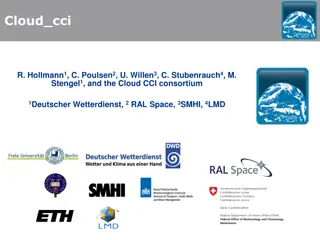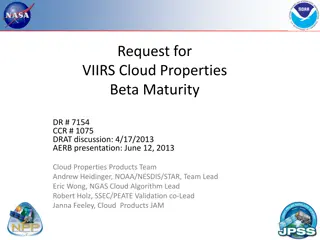Understanding Availability Zones in Cloud Infrastructure Design
The article explores the significance of Availability Zones (AZs) in cloud infrastructure design, focusing on improving resiliency, redundancy, and resource management. Learn about Cleura's innovative AZ-aware cloud solutions and how they enhance the reliability and performance of cloud services.
Download Presentation

Please find below an Image/Link to download the presentation.
The content on the website is provided AS IS for your information and personal use only. It may not be sold, licensed, or shared on other websites without obtaining consent from the author. Download presentation by click this link. If you encounter any issues during the download, it is possible that the publisher has removed the file from their server.
E N D
Presentation Transcript
Deploying AZ-aware cloud with OpenStack-Ansible An Iver company
Who we are? We Are OpenInfra! An Iver company
OpenStack-Ansible Project Team Leader OpenStack Technical Committee Member Cloud Engineering Domain Leader @ Cleura Dmitriy Rabotyagov IRC: noonedeadpunk An Iver company
Cleura, the European cloud PUBLIC CLOUD Our public cloud can power any type of workload, whether container-based, serverless, or traditional. Use your favorite tools to automate. At the core, we offer global computing power, networking, and storage based on open source technologies which give you endless possibilities. COMPLIANT CLOUD Compliant Cloud is IT infrastructure with built-in regulatory compliance for industries regulated by specific laws, regulations or customer demands. It is a fully fledged IaaS for organisations who are required to store data in specific locations where auditability, traceability and dependability of physical and logical access is of particular importance. Only in Public cloud we currently manage: 6 regions PRIVATE CLOUD 60TB of RAM Private Cloud from Cleura is a turnkey solution for anyone in need of a complete OpenStack- based cloud. We build your cloud, based on your specific needs, from the ground up and hand over the keys to your very own cloud management system. Depending on your needs, we can manage your private cloud allowing you to focus on allocating resources from your very own managed private cloud. 4500 CPU cores 5.88 PB of storage ISO CERTIFIED Infromation security: ISO 27001, 27010, 27013, 27017, 27018 Resilience: ISO 22301 Environmental management: ISO 14001 Quality Assurance: ISO 9001 An Iver company
Why we started looking at Availability Zones? Improve resiliency and redundancy Use isolated fire rooms (or datacenters) Provide common API for managing resources Customer requests An Iver company
Designing Availability Zones An Iver company
Basic architecure In Each Availability Zone we have: Member of Galera Cluster Member of RabbitMQ Cluster API backends of OpenStack services Loadbalancer Hypervisors Network nodes Storage You can share networks or storage between AZs if needed An Iver company
When to consider Availability Zones? AZ can help you if: You want to share resources between AZs (like networking or storage) Distance between regions is small enough and conenction is fast and cheap It is business or customer requirement What AZ won t do: Improve OpenStack control plane resilience Scale out load from rabbitmq or galera Not all OpenStack Services support AZs An Iver company
Redundancy of services To reduce traffice between AZs, loadbalancer does prefer passing traffic to the backends in it s own AZ In case of backend outage in AZ, balancer will pass traffic to other AZs In case of AZ being fully unavailable API will remain functional. Neutron agents can failover if tenant networks are shared An Iver company
Balancing incoming requests Using VRRP Using anycast Implemented on loadbalancers Implemented on infrastructural level Requires L3 connection between AZs Makes limited sense if AZs are too close to each other An Iver company
Deploying Availability Zones An Iver company
Automating deployment? OpenStack-Ansible! We use OpenStack-Ansible as our daily driver to deploy, configure and upgrade all our regions. We not only consume OpenStack-Ansible, but also actively contribute back our findings, including new use-cases, bug fixes and various improvements of deployment and upgrade workflow. We feel confident to run playbooks anytime we need to implement configuration chage or restore service to it s desired state as Ansible is idempotent by design. An Iver company
OpenStack-Ansible is flexible, thus powerful! Can deploy: In LXC containers On bare metal Install services: In virtualenvs With distro packages Operating systems: Ubuntu Debian CentOS Stream Rocky Linux An Iver company
Configuring OpenStack-Ansible An Iver company
Playing with inventory Define Availability Zones as groups We need to have AZ specific groups. All services, that will be deployed inside AZ will be children of this group. Map hosts to AZ groups Now we can use these groups and add hosts to it. This way we tell dynamic_inventory, that we want to deploy openstack services and infrastructure on all 3 controllers, but add each controller with all it s children to appropriate AZ group. Use AZ-specific networks if needed In case you do not share storage between Availability Zones you will need to add more storage networks to the deployment. For that define these networks and map them to defined groups. You can also define extra groups for these networks As simple example you might need to have multiple independent sets of cinder-volume services, as only cinder-volume in current AZ can reach and manage storage. An Iver company
Configuring variables Define Availability Zone name under group_vars/az1_all Define required overrides under user_variables.yml An Iver company
Configuring LoadBalancer Listen on interfaces instead of IP addresses Use backend in own AZ first, fallback to others when required Use central backend for some services (like mariadb) An Iver company
Configuring VRRP for DNS RR Define interfaces which will be used for Keepalived communication and IP addresses that will be spawned on them by keepalived Define keepalived VRRP instances An Iver company
Thank you! Questions? IRC: #openstack-ansible on OFTC Documentation: Check our website: An Iver company























